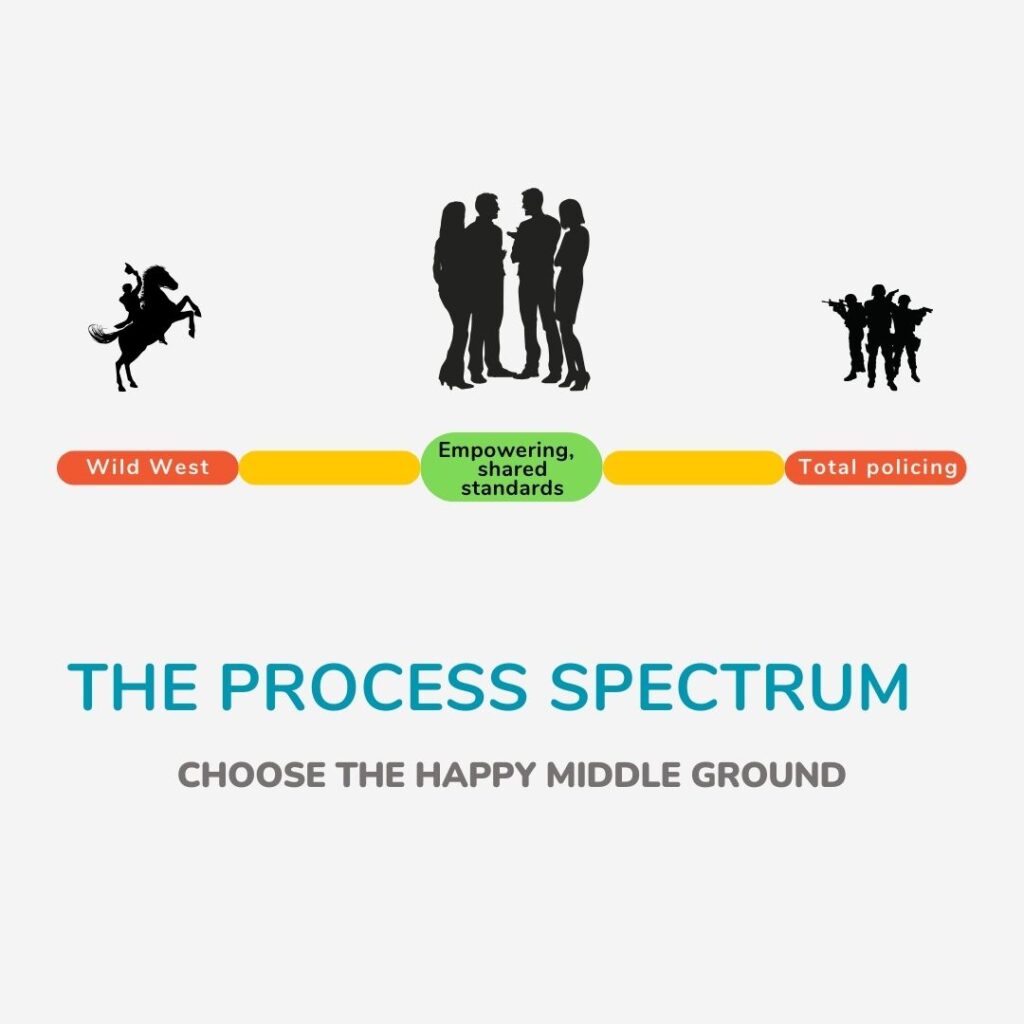What do you think when you hear the word “process”?
Increasingly, it’s a word that seems to provoke shudders and heeby jeebies in the corporate world. In a fast-moving world, the word “process” has been chucked into the same mental draw as “process-driven”, “bureaucratic”, “slow moving” and “authoritarianism”. And for a certain type of organisation, it has become a contentious topic of conversation.

Throughout this year, we’ve talked to organisations who’ve said:
- “We’re allergic to process”
- “We don’t do process”
- “Process blocks creativity”
- “Process is last century”
It’s a point of view that sees process as stifling – as something that puts the brakes on innovation and free thinking. It sees “process” as rigid, uncompromising and heavily policed.
The implied alternative implied is a freer, faster and much more flexible approach that gets more innovative, actionable results.
But is process all bad?
I can’t find enough ways to say no, no it isn’t.
Look up process in the dictionary, and you’ll get a definition that goes something like this: Process is the series of steps necessary to achieve a task.
When you think of it like this, process isn’t simply not bad. It’s absolutely inevitable. Especially if you’ve created something really amazing and want to empower lots of other people to make it or do it too. You have to share the process with them – the necessary steps to getting it right.
Pretty much everything that’s useful has a set of rules involved with how you do it. Take driving, for example. At very top level, all road users have a shared goal. They want to get to where they’re going alive and intact. And for this reason, the vast majority of road users adhere to some basic rules.
Here in the UK we drive on the left. We give way where the signs tell us to. We stop at red lights. There are sanctions in place if we don’t. The rules aren’t there to dampen our creativity. They’re there to make sure that the 35 million people in the UK who own a driving license don’t routinely bash into one another.
Or cooking. Do you have to slavishly follow a recipe every time you whip up a new dish? (Or indeed, sling some frozen chips into the cooker?)
It depends what results you want to get and the experience you already have. You may already know that the chips will take about 20 minutes on gas mark 5. And you may know your granny’s sponge cake recipe well enough to adapt it on the hoof.
But imagine you need a commercial kitchen to produce half a ton of chips a day. Or a hundred Victoria sponges. This is when you need standardisation and process.
Describing the steps your kitchen team needs to take allows them to create a product that’s recognisably the same every time. It keeps the kitchen buzzing productively. And it helps to free up time for innovation.
Am I suggesting that corporate strategy, brand work or innovation is the same as banging out vats of chips? Not really.
But maybe a little bit.
A little bit in that there are always elements of work that can be standardised and made repeatable – and that the more this happens, the faster the whole thing will be able to move along. It also means that performance metrics become possible.

So if you’re creating a document, it helps if the general steps and rules include:
- Defining a purpose for the document (audiences, intended outcomes)
- Agreeing key messages
- Understanding any regulatory requirements
- Agreeing the format of the document
- Adhering to brand style and tone of voice
- Agreeing deadlines
- Agreeing which stakeholders will be involved in approving the document, how and when
Miss any of these steps, and the document can get stuck in a doom loop of endless versions, because everyone involved has a different version of what it will exist to achieve and they won’t be available when they’re needed. You then either release something that’s a cobbled-together mess. Or, the project fizzles out and comes to nothing.
Brilliant process is essential. And it’s a bit like plumbing. When you live in a building with incredible plumbing, you have no idea it exists. You just think about having another lovely bath. You only notice it when it doesn’t work, or works in ways that isn’t convenient to you.
So why is the thought of process becoming more and more of a no-no? There are a number of reasons, including:
Everyone has experienced poor, restrictive processes

We’ve all had the experience of trying to use project management software that forces you to work unintuitively. A lot of us have had the experience of using poorly documented IT or time management processes, where everything’s a pain.
But to go back to the plumbing analogy. I have lived in houses where there’s only hot water if you remember to switch on (the very expensive) immersion heater. Which meant even simple things like washing the dishes has to be scheduled around the needs of a stupid boiler.
If you work in a business where process only works to its own schedule, then of course you’re going to find it frustrating. So get rid of what doesn’t work and install a better system instead.
In some organisations, all process roads lead to “no”

If you work in a regulated environment and want to do something a little different or creative, existing process can feel like it’s set up to make it fail. Every financial services copywriter has had a brilliant piece of content rejected because a compliance colleague had never seen anything like it before. In the same vein, it’s not unusual to get ideas knocked back by legal colleagues.
Yes, this feels like evil process. But it’s often a severe lack of flexibility. The job of legal and compliance is to protect their organisations from risk. And it can feel like doing things in exactly the same way every time is a brilliantly risk-averse way of operating. But in a rapidly changing business environment, good process should empower innovation, rather than being set up to stifle it.
Because if legal and compliance aren’t open to innovation, your teams may give up even trying to keep ahead of the curve.
Setting up processes can feel like the opposite of entrepreneurialism
You’ve got a brilliant product you want to sell. You’ve got roadmaps to implement and exciting creative work to do. So why would you spend time faffing around by documenting steps and getting everyone to follow them? Surely if you’re working in an entrepreneurial environment, everyone should just be able to do their own brilliant thing and keep the bucks coming in?
To a point this can kind of work. You can have different colleagues bringing in business in their own ways. Or product developers all following their own creative star. Your business can still make progress and money, even if every colleague is doing their own thing. But my God, you’ll be wasting a lot of time and energy while you’re doing it.
Much better to decide what works for your organisation, set out the steps involved – and decide regularly if you need to make tweaks to the process if circumstances change. Commonly followed processes do take time to set up. But not doing it is a false economy.
Adhering to process means accepting team rules
For process to work, everyone’s got to accept it. You can’t have some drivers who decide that driving on the other side of the road is just their thing, and everyone else will have to get along with it.
To get mass acceptance, you need to create process in consultation. Otherwise you’ll be creating crappy process that doesn’t take enough people’s needs into account.
However, even when you do this, there will nearly always be someone who doesn’t want to play ball. (Becky’s got her own system for filing… it makes complete sense to her, but don’t ask me to find anything she’s working on!)
This doesn’t mean having a process for filing is unnecessary. It just means Becky either can’t be arsed to do things properly, or she doesn’t want other people to be able to access her files.

This secret squirrelling of files is more common than you might think. Of course all big organisations have a standard Microsoft or Cisco shared platform. And all start-ups love a bit of Google Docs. But when we’re rolling out a new approach to language across an organisation, for example, one of the things we know we need to do is have an amnesty (and then crackdown) on desktop storage.
Let’s say we’re implementing a new suite of templated documents. We always, always find people who have decided they prefer their own versions, and store them on their desktops. This means there’s inconsistency – and it makes it more difficult to measure impact.
This is where process can feel like it’s tipping into “policing” for some team members. They have their own relationships with clients, they have their own preferred ways of doing things – so why won’t their employer just let them get on with it? They steadfastly resist and subvert the processes the majority of their colleagues follow.
So how do you make brilliant processes that work?
The processes I know really well are to do with things like writing, content creation, editorial, tone of voice and messaging roll-outs. But I’m guessing that the approach to creating process for these things could be useful in other areas of business too. So these are my thoughts on how to go about creating process that’s enabling:
- Review existing processes regularly
If people aren’t adhering to them, is it because the processes are out of date? Or were they never quite right? Map the process out, identify pain points and think about what could become more efficient or empowering. Set an expectation that process should be open to examination and improvement.
- Take time to understand how processes affect people
Get people to share their experiences of working within processes. Can people easily access the platforms they need to do their work? Are there gatekeepers in the process that are acting as blockers? Are timings adequate? What’s driving people nuts? You won’t know unless you ask.
- Know who owns the process
A good process has many practitioners and only one owner. The owner can be a person, a team or a steering group. If the process isn’t owned, it’s almost guaranteed to mutate and become less useful.
- Be open to creative possibilities
Don’t assume that the ways you’ve always done things will always be relevant. We live in exciting times, with a lot of possibilities available to us. So be open to automation and potentially time-saving technologies.
- Create a new process and test it
When you’ve identified what could be working better, create a new process. If you can show it as a diagram, brilliant – this will make it easier to follow. Set clear roles and responsibilities within the process so that anyone involved knows exactly what they need to do. Take your new set of steps and test it on a small, easy-to-measure project. Then ask more questions. Did people involved in the project find the new process easy? Did they use the process or sidestep it? Take their feedback and use it to make further improvements.
- Market the process
This is an easy step to forget. But remember, there are people in your business who find the whole thought of process annoying and niggly. These are the most important people to reach and get on board. So market the new approach to them. Show them what’s in it for them – and for the business.
- Create awareness and feedback loops
Make sure teams know about the process – and what you expect them to do. If people need training, make it available. It’s also useful to create a mechanism for people to be able to feed back on the process at any time. Have a suggestions box and take any submissions seriously.
- Go back to step one
Nothing stands still – so check in with your process every six months. Is everything still working brilliantly? Great. Has something changed? Then it’s either time to get things back on track, or update the process.
Good process is essential

Most businesses have processes for claiming expenses, booking time off and ordering equipment. It would feel really weird if they didn’t. (Expenses? Oh we just freestyle it, Nigel… have a company credit card and treat it as you will…)
Good, sensible process should be an enabler. It should empower productivity and provide a shared language for how a team is making progress.
It should be a platform for creativity, innovation and collaboration. And it should certainly be part of the flexible infrastructure that makes organisations resilient.
So by all means, be allergic to bad process.
But don’t decide that your organisation will thrive by winging it.
